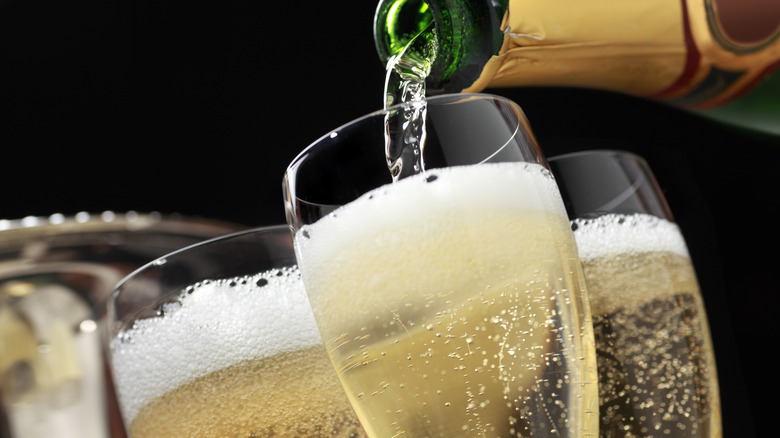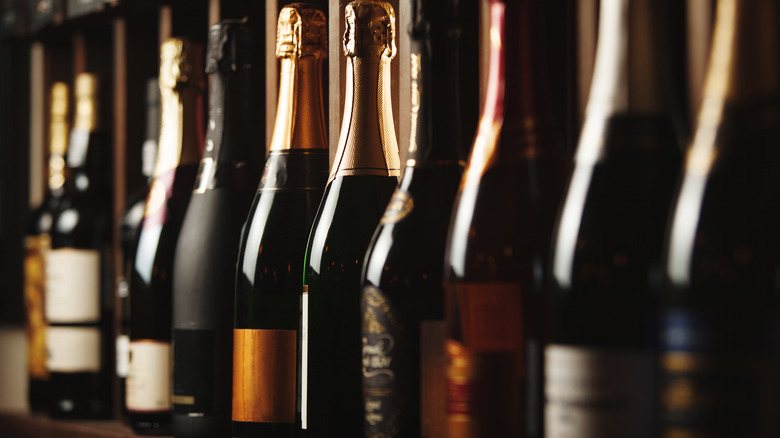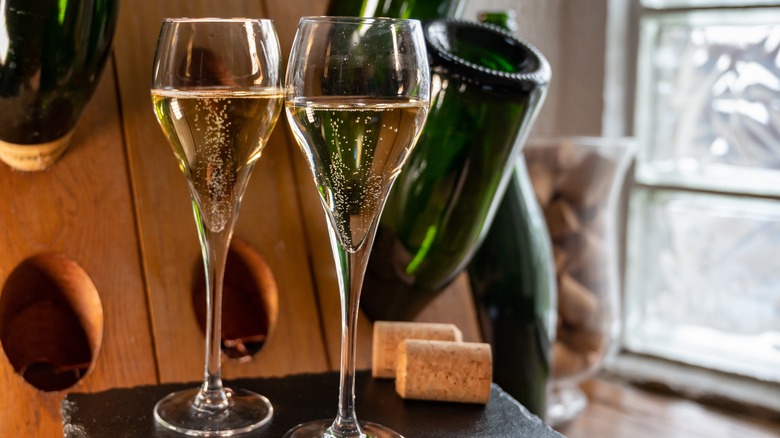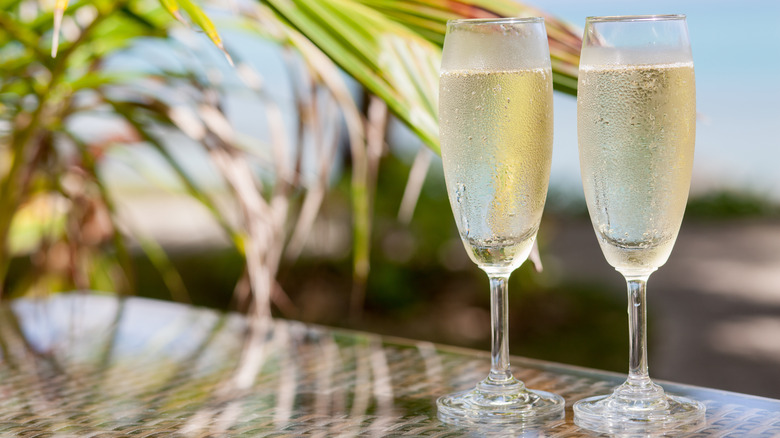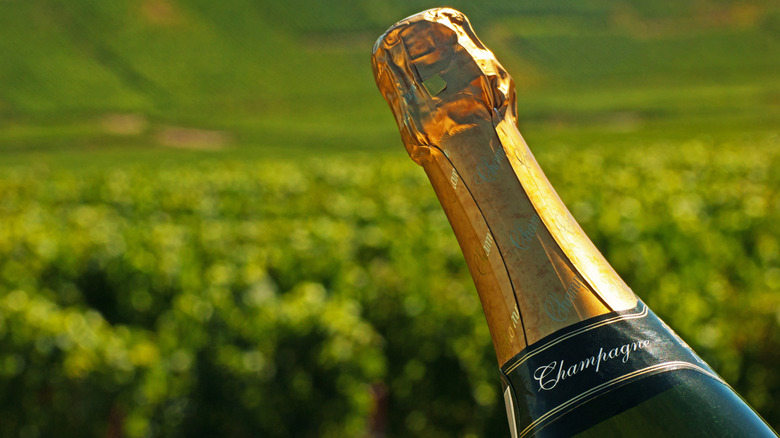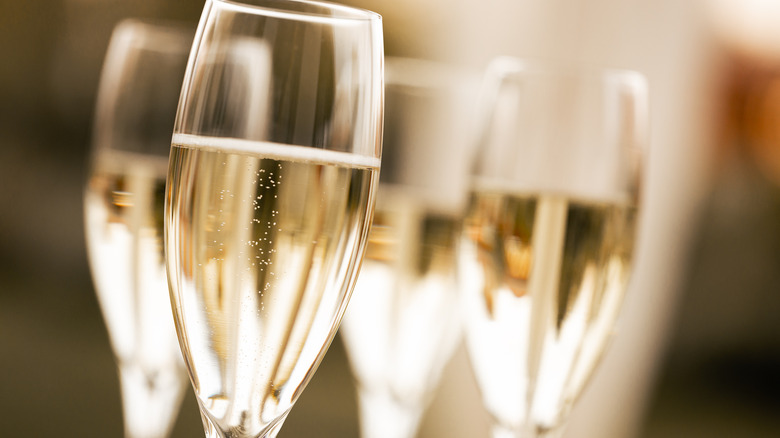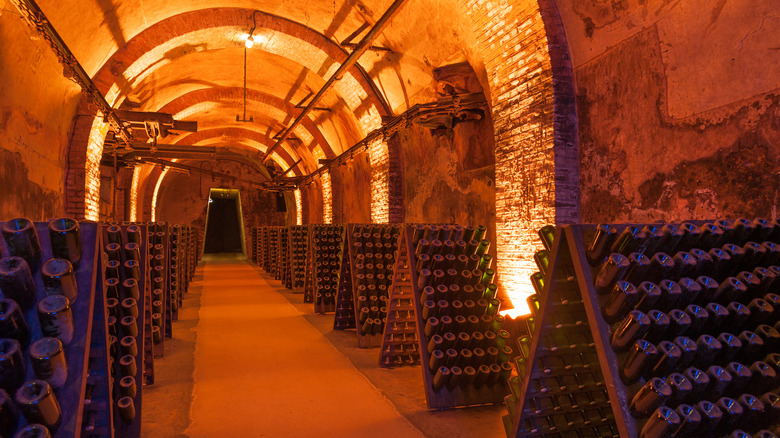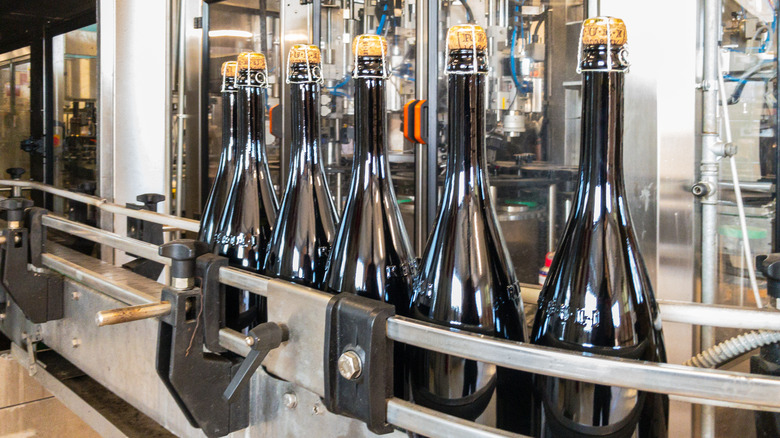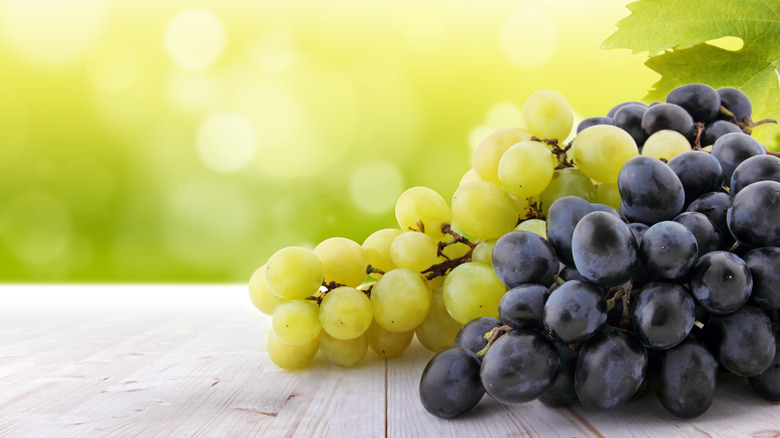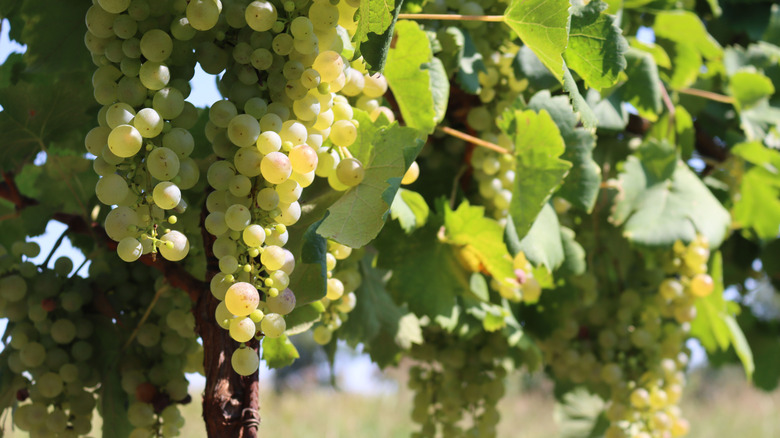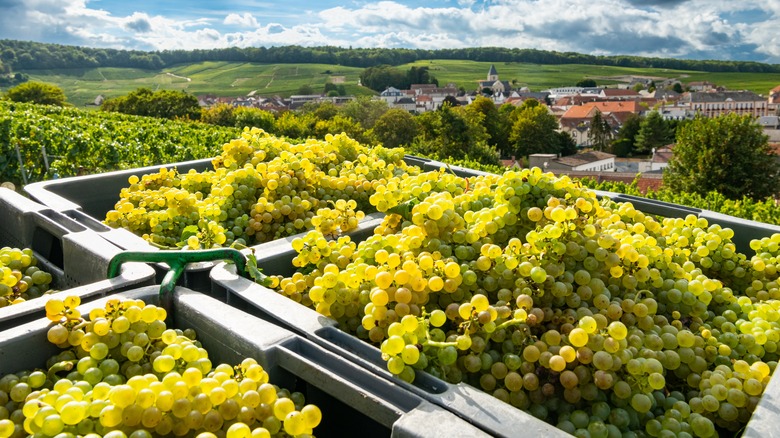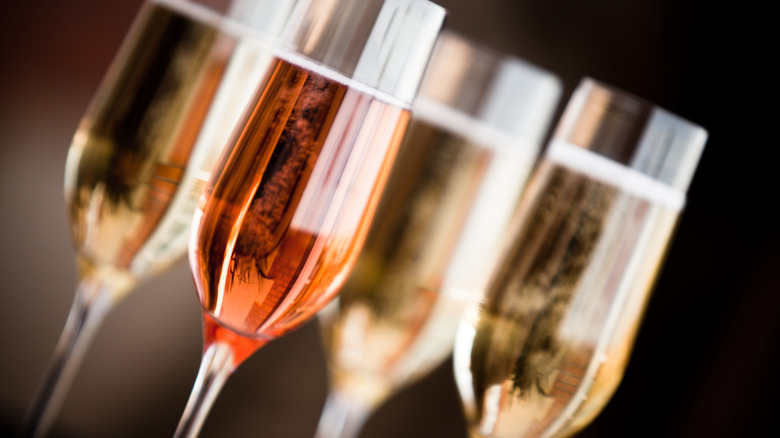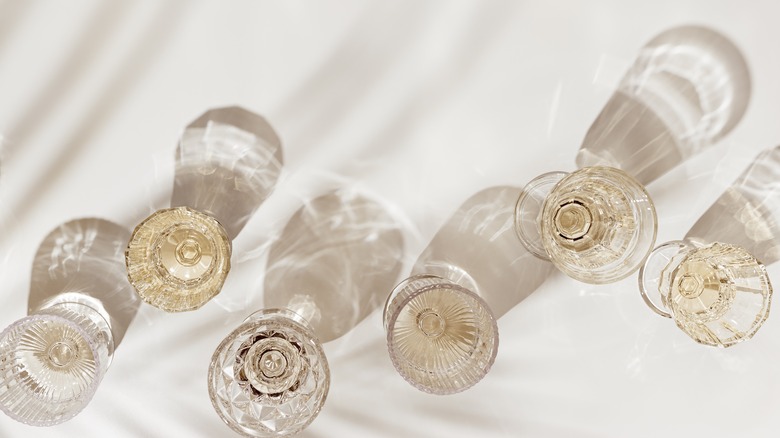Champagne, Prosecco, And Sparkling Wine: What's The Difference?
When it's time to celebrate a milestone, special occasion, or just because it's a day that ends in Y, nothing is more festive than an effervescent glass of sparkling wine. But when faced with the endless shelves of hefty-looking bottles or numerous inscrutable options on a wine menu, choosing one is a process that can be confusing and intimidating. It's hard to know what's dry or sweet, crisp or creamy, and whether a wine is worth the price tag.
Arming yourself with a basic understanding of sparkling wine — what it is, where it comes from, and its different styles — is crucial to navigating the vast world of this bubbly beverage. As a longtime sommelier and certified wine specialist, even I get overwhelmed sometimes, and that's when I know it's time to review the fundamentals. Starting with two of the world's famed and most popular styles, Champagne and Prosecco, I've compiled some facts about these two types, and sparkling wine in general, that are sure to help you purchase and order like a pro. That way you can focus on what's important: Drinking, sharing, and enjoying them.
What is sparkling wine?
All Prosecco and Champagne is sparkling wine, but not all sparkling wine is Prosecco or Champagne. Sparkling wine is a broad category that includes both of those famous styles, as well as countless others from all over the world. Basically, any wine that has bubbles is considered a sparkling wine. It can be made from any grape and come from any country, and any method can be used to add the style's signature sparkle.
There are many ways a winemaker can take a wine from still to sparkling. The more time-consuming and labor-intensive methods involve multiple rounds of fermentation — the first ferment creates alcohol, and the second creates bubbles. There are cheaper and quicker ways to add fizz to still wine, including carbonation, the same process used to make your favorite sodas. Since any wine can become sparkling, you'll find bottles of bubbly in as many shapes, sizes, and colors as still wine.
What is Champagne?
Champagne is a small region in northern France that is best known for the sparkling wines made within its borders. If you see a bottle labeled Champagne, it is from this area and has been crafted through a meticulous and well-regulated process (although there are a few California producers who are somewhat controversially allowed to use the name, thanks to a legal agreement with the EU). Champagne is a heavily protected product with a reputation for exceptional quality, considered by many to be the gold standard when it comes to sparkling wine.
While wines have been produced in the region of Champagne for millennia, the bubbly version we know today didn't come around until the 1700s. Technological advances such as thicker, stronger glass and better quality corks allowed the pressurized liquid to be transported safely and without losing its fizz. These innovations, along with Champagne's location as a trading hub and its proximity to Paris, allowed the wine's popularity to spread and its reputation to grow. Champagne can be made in white and rosé styles, and can range from bone dry to sweet.
What is Prosecco?
Prosecco is Champagne's biggest head-to-head competitor when it comes to sparkling wine popularity. It often eclipses Champagne when it comes to sales by volume, thanks to its lower price tag which makes it accessible to more people. Like Champagne, Prosecco is a protected product, the name of which signifies a wine made in a certain part of northern Italy using a particular process, primarily made from a specific grape.
There are many different styles of Prosecco, including white and rosé, made with different levels of sweetness. While Prosecco is generally not considered as serious a sparkling wine as Champagne, there are some very high-quality bottles out there, often coming from specific subregions that are focused on expressing their own individual character. But there's also plenty of Prosecco that is fun, easy-drinking, and perfect for topping off cocktails like an Aperol Spritz or popping open at a casual picnic.
Where do Champagne and Prosecco come from?
Both Champagne and Prosecco come from delineated regions within France and Italy, respectively. To understand why this is important, you should get to know a somewhat esoteric winemaking concept: Terroir. The exact definition of this word when it comes to wine is debated, but generally, it refers to all of the elements of a physical place that influence the wine that is made in that area. This can include the soils, altitude, and slope of the vineyards, the climate, and even the strains of yeast that populate the winery. These pieces fit together to create wines that are unique to these places and express a sense of their origin in their aromas, flavors, and structure.
The region of Champagne is known for its famous chalky limestone soils, which store water to keep the vines hydrated during dry seasons while still allowing for drainage. In the Prosecco winemaking region, soils are more varied. Champagne experiences a cooler climate than Prosecco, which hinders the development of ripeness in grapes. While this sounds like a drawback, less ripe grapes have higher acidity, which makes them perfect for serious sparkling wine production. Prosecco's warmer temperatures create grapes with riper, richer, fruitier flavors. There are many subtle differences between these two parts of the world that influence the way each wine tastes.
Sparkling wine can be made anywhere in the world
Prosecco and Champagne are not the only sparkling wines tied to a specific place. You can find unique terroir-driven bubbly in pretty much any country that makes wine. There's rich, deeply flavored red sparkling Shiraz from Australia, Champagne-esque Cap Classique from South Africa, and delightfully aromatic Sekt from Germany, to name a few. All of the other winemaking regions in France and Italy make different types of sparkling wines, too, like Crémant de Bourgogne from Burgundy, and Franciacorta from Lombardy.
While sparkling wines from around the world vary wildly in style and taste, there is a more-or-less standard scale for sugar so you know how sweet or dry the wine is. Brut designates a dry style, demi-sec or doux means the wine is sweet, and sec or extra dry signifies that the wine's sugar level is somewhere in between. There's a sparkling wine variety out there for everyone's palate, and the only way to find your favorite is to taste your way around the world of bubbles.
How are Champagne and Prosecco made?
While there are many ways to create a sparkling wine, Champagne and Prosecco must each only be made using a specific method. For Champagne, the method is known as la méthode champenoise, or the Champagne method. It's a complicated and laborious multi-stage process in which the wine's second fermentation, the one that creates bubbles, occurs within each individual bottle. Crafting wines in this way is not just time-consuming, but also very expensive, which is one of the reasons for Champagne's hefty price tag — but it results in wines that have layers of complexity, richness, and texture along with fine, elegant bubbles.
Prosecco is made using what's called the Charmat method, or the tank method. Instead of the second fermentation occurring inside each bottle, the wine is fermented in bulk in large stainless steel tanks. These wines may not have the depth or refinement of Champagne, but they tend to have brighter, fresher flavors and a sunny disposition. This is a less costly method, which contributes to Prosecco's affordability.
Sparkling wine can be produced using many different methods
When the Champagne method is used to create wines outside of Champagne, it must be called the traditional method, as the name is protected even in the description. The traditional method is used by winemakers all over the world who want to emulate Champagne's flavor profile. Cava from Spain is a famous example of a traditional method wine, but you can also find others made in locations from California to Tasmania.
Prosecco's tank method can also be used to make wine anywhere, including other parts of Italy — it's the process used to make Lambrusco in the Emilia-Romagna region. Since it takes less time and money than the traditional method and still creates high-quality sparkling wines, it's a popular technique with winemakers around the world. An even cheaper method is carbonation, which is exclusively used for lower-end products.
Another method, which has gained popularity in recent years, is known as the ancestral method. This process involves bottling a wine as it's going through its first fermentation, trapping the bubbles inside. Because it only goes through a single fermentation, a wine made using this technique will not be as alcoholic or bubbly as other styles. If you've ever had a fizzy glass of pétillant-naturel or pet-nat, as it's known to wine hipsters, you've enjoyed an ancestral method sparkling wine.
What grapes are used to make Champagne?
For heavily regulated wines like Champagne, there are a lot of rules that govern its production. One of these dictates which grapes can be used to make it. While there are eight grape varieties allowed in Champagne, only three are widely used: Chardonnay, Pinot Noir, and Pinot Meunier. If you know grapes, you'll notice that Pinot Noir and Pinot Meunier are typically used to make red wines, yet the majority of Champagne wines are white. That's because wines from these grapes only get their dark color if the juice is left in contact with the skins. If the grapes are gently pressed and the skins are removed, the clear juice can be used to make white wine. And of course, some Champagnes are rosé, in which case the red grapes come in handy for their color.
Many Champagnes are blends of these three grapes, as each one brings its own unique aromas, flavors, and structure to the finished wines. If you see one labeled "Blanc de Blancs," that means it's only made from white grapes — typically, just Chardonnay. Some, labeled "Blanc de Noirs," are only made from red grapes, although the wine itself is white.
What grapes are used to make Prosecco?
While Champagne wines are made from a selection of different grapes, Prosecco is primarily made from one variety: Glera. In the not-so-distant past, this grape was most commonly called Prosecco, the same as the wine, but it turns out that a grape name cannot be granted legal protection in the same way that a region can. So in the quest to protect their wines, the producers of Prosecco decided to refer to the grape by a little-known synonym, Glera, and use the name Prosecco to instead describe the region. This little scheme of shifting names was successful, and Prosecco is now a protected product, just like Champagne.
Glera grapes must make up at least 85% of any Prosecco wine. For rosé versions, the remaining percentage includes Pinot Noir, while for white versions, a large number of other grapes can be used to complete the wine, including Chardonnay. In either case, Glera is the headline act in every bottle of Prosecco, whether white or rosé, dry or sweet.
Sparkling wines can be made from any grape variety
Sparkling wines around the world can be made from any grape variety or blend of grapes. Outside of the confines of specific controlled sparkling wine regions, winemakers are free to experiment with all kinds of styles, using various methods and grapes to create their own unique bubbly concoctions. While some are made to mimic styles like Prosecco and Champagne, others are in categories all their own.
It's not always easy to know what grape variety or blend of grapes has been used to make a sparkling wine, as it's often not listed on the label. So if you're looking to try something off the beaten path, don't hesitate to ask for guidance, whether you're at a wine shop or a restaurant. Say you typically drink still Riesling, or Cabernet Franc, or any other grape you can think of — guaranteed, there's a sparkling version out there that you'll probably love. Or you may be introduced to a grape you've never heard of that's made into your new favorite sparkling wine. A little guidance can make exploring these unusual wines easy and fun.
What does Champagne taste like?
The taste of Champagne can vary greatly, depending on the particular wine's style, but generally, they're going to give you lots of complex aromas and flavors ranging from fruity to minerally, delicate to intense, and everything in between. Every step of the lengthy Champagne-making process, from the first fermentation to the final aging of the bottles, adds another intricate layer to the wine.
Your basic Champagne will typically exhibit both red and white wine fruit flavors from the blend of grapes, like lemon and green apple along with berry and cherry. You'll typically also find a floral and mineral component, as well as nutty and toasty notes often described as marzipan or brioche. Champagne wines are known for their brisk acidity, which makes your mouth pucker, acting as a palate cleanser when paired with food. Many Champagnes have a rich, creamy texture, as well, giving them an opulent and luxurious mouthfeel. If you've treated yourself to a fine Champagne and it seems one-note, try letting it warm up a little — if you drink it while it's too cold, its full spectrum of aromas and flavors won't be able to fully express themselves.
What does Prosecco taste like?
Prosecco is all about fruit and freshness. Glera grapes give an abundance of pleasing fruity flavors like melon, peach, pear, and a zing of lemony citrus, along with floral notes like honeysuckle. Because of its intense fruitiness, even a brut Prosecco can come across on the palate as sweet, particularly when compared to a brut Champagne. Sweeter styles will be labeled dry or extra dry, somewhat confusingly.
Prosecco's tank method of production focuses more on preserving the bright flavors of the grape, rather than transforming the wine into a rich, toasty tipple. The bubbles are softer and less intense than those of Champagne, as well. This gives Prosecco a more casual vibe than its French cousin, although it doesn't mean there aren't Proseccos with plenty of complexity and depth of flavor. There are several subregions of Prosecco that produce very high-quality wines. They tend to have incredibly long tongue-twisting names — just look for the letters DOCG on the label, which denotes the places from which you're likely to find the best Prosecco bottles. They cost a little more than your basic Prosecco, but they're still a bargain compared to Champagne.
What does sparkling wine taste like?
Since sparkling wine is such a vast and varied category, it's impossible to generalize what it tastes like. The full spectrum of wine flavors and colors can be found in the world of bubbly, so whatever flavor profile you're looking for, there's bound to be a bottle that will please your palate. The best way to find out what type of sparkling wine you like is to taste as many different types as you can.
Remember the sweetness levels — if you prefer a dry, crisp sparkling wine, look for the word brut on the label (look for brut nature if you like your wine bone dry). Sweeter wines start at extra dry, with demi-sec or doux giving you the most sugar in your glass. If you typically enjoy red wines, try a Lambrusco or sparkling Shiraz. You'll find unique hidden gems from countries you may not immediately seek out for wine, like Moldova, Georgia, and even England. You could spend every day of the rest of your life tasting sparkling wines and never have the same one twice.
Is one better than the others?
Wine enjoyment can be highly subjective, so there's no such thing as the "best" wine, whether it's still or sparkling or any other style. Everyone's palate and preferences are different. Also, it's important to remember that a wine's price tag doesn't necessarily denote how "good" or "bad" it is — it's a reflection of so many things, from the price of the land the vines are grown on, the cost of the barrels it may be aged in, to the marketing budget of the winery. It has nothing to do with how the wine tastes, or how much you'll likely enjoy it.
You may prefer Prosecco to Champagne, or vice versa. Or there may be another type of sparkling wine out there that fills you with giddiness whenever you crack open a bottle. The bottom line is, sparkling wine of all kinds is meant for jubilation and pure enjoyment, so don't limit yourself to just one. Every day there's a reason to celebrate with a glass of bubbly.
